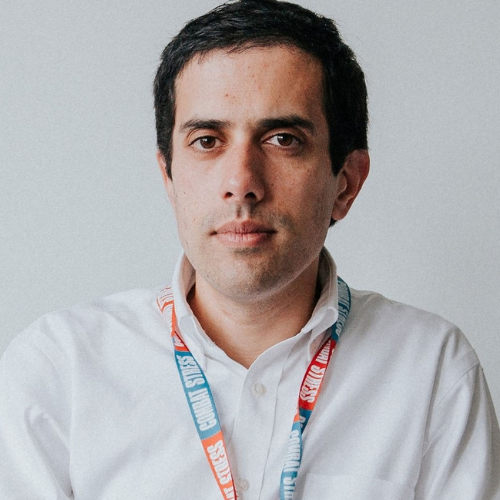
Meet the Expert - Professor Dominic Murphy
Welcome to 'Meet the Expert', our series bringing you informative interviews with Armed Forces researchers, policy makers and service providers. Read on to learn about current work, aspirations for progress and future work, and insights into expert perspectives on key issues impacting ex-Service personnel and their families.
 In this issue, we interviewed Professor Dominic Muprhy, Clinical Psychologist and Head of Research at Combat Stress and Professor at King's Centre for Military Health Research (KCMHR). Dominic is President of the UK Psychological Trauma Society (UKPTS) and Executive Board member of the European Society for Traumatic Stress Studies (ESTSS). He is also a member of the Five Eyes Veterans Mental Health Consortium and works on NATO research task groups.
In this issue, we interviewed Professor Dominic Muprhy, Clinical Psychologist and Head of Research at Combat Stress and Professor at King's Centre for Military Health Research (KCMHR). Dominic is President of the UK Psychological Trauma Society (UKPTS) and Executive Board member of the European Society for Traumatic Stress Studies (ESTSS). He is also a member of the Five Eyes Veterans Mental Health Consortium and works on NATO research task groups.
1. Please tell us about your background and how you came to be involved in work relating to the Armed Forces Community?
I have been working with the Armed Forces Community since 2003. I was completing my MA in Psychology at Glasgow University during the initial 2003 war in Iraq and was due to move down to London. After my final exams, I was reading the newspaper and saw an advert for a role at King’s College London helping set up a large epidemiological study to explore the potential impact of deploying to Iraq. I applied and was lucky enough to be offered the job. It was an excellent fit for me as it brought together my interests in mental health, research and supporting the military community. To build upon these experiences I decided to enrol on a PhD and was the first PhD student of the yet to be formed, King’s Centre for Military Health Research (KCMHR) under the supervision of Professor Sir Simon Wessely. From here I completed a second doctorate; but this time in Clinical Psychology, which allows me to work as both a clinician and an academic. In 2013, I joined Combat Stress to establish and run a research department co-located between Combat Stress and KCMHR. Whilst at KCMHR we aim to research the range of needs of the whole Armed Forces Community, the Combat Stress Research Department was set up to focus specifically on the needs of those affected by mental health difficulties. I am extremely proud of the work of the Combat Stress Research Department, and we recently celebrated our 10th anniversary. To mark this, we published a report to summarise the past decade of research.
2. What research projects are you currently working on and how do they fit into the bigger picture of understanding and supporting the Armed Forces Community?
My focus is quite broad, but I wanted to take this opportunity to discuss three projects that fit together. One of my aims has been to understand how best to support those from the Armed Forces Community that may not be well served by current gold-standard treatments for Post-traumatic stress disorder (PTSD), or those who are members of under-represented groups.
Within the field of psychological trauma there have been some exciting developments over the previous few years. One of these is the new diagnosis of Complex PTSD (CPTSD). This is important because it recognises the multi-faceted impact of psychological trauma and has led to a better understanding of those from the Armed Forces Community exposed to complex trauma. We conducted the first study internationally to validate the new diagnosis of CPTSD within military populations and then completed a further study to explore the effectiveness of a new treatment for CPTSD. This was a randomised controlled trial (RCT) where we compared the new treatment called Enhanced Skills Training in Affective and Interpersonal Regulation (ESTAIR) to treatment as usual. We are coming to the end of this project, and I am delighted to say we observed that Veterans treated with ESTAIR reported bigger improvements in their symptoms of PTSD and other outcomes (such as depression and anxiety).
A second study we are working on within the area of psychological trauma is to develop a new treatment for moral injury. Moral injury is described as ‘intense psychological distress which results from actions, or lack of actions, from experiences which clash with an individual’s moral or ethical code.’ To put it more simply: something you did (or could not do) that felt totally against your morals. We have been conducting a number of linked studies, to first better understand the concept of moral injury, then to develop a new treatment called Restore and Rebuild (R&R), and now we are currently conducting an RCT to test out the efficacy of R&R.
If both ESTAIR and R&R are found to be effective, we would aim for these to be adopted by Veteran mental health services (both with the charity sector and the NHS) and rolled out nationally to ensure that our Veteran community are being supported by the best treatments available.
The final project I wanted to mention is about supporting women Veteran survivors of military sexual trauma (MST). MST is broadly defined as experiences of sexual bullying, harassment or assault which take place during military Service. Unfortunately, our research in the UK (and research conducted by others in America and Canada) has shown that upwards of 1 in 4 women Veterans report having experienced MST during their military careers. Further, we know that MST is related to a number of negative health outcomes as a Veteran. To attempt to address this, we co-produced evidence-based guidance. This allowed us to understand what are the best psychological treatments available to support survivors of MST and understand from those with lived experience and consequently how best to offer these interventions to make women Veterans feel better able to engage in treatment. We are currently conducting a project that aims to take these findings and build capacity across the Armed Forces sector to support survivors of MST. We are doing this by offering free training to policy makers, service planners, healthcare professionals and mental health clinicians across the UK within both specialist Veteran services and in non-Veteran services. For example, the training will provide practical co-produced guidance for how to adapt services to better support women Veterans to engage with them, and training in the best evidence-based therapy to support survivors of MST.
3. What other research or policy areas relating to the Armed Forces Community are you especially passionate about or feel need further attention? Please expand on this and tell us about them, as much as you can.
Families, families, families. Understandably, mental health professionals often focus solely on the needs of the client seeking support. However, we know that the impact of mental health can have a ripple effect on those around this person. One of the areas of research I am most proud of is the work we have done to understand how best to support partners living alongside Veterans with PTSD and other complex mental health difficulties. This was one of the first major programmes of research I initiated after I set up the Combat Stress Research Department. Over a series of linked projects, we scoped out the needs of partners through mixed-methods projects. From there, we developed a treatment package named The Together Programme (TTP), which was incidentally named by the participants themselves. This programme was piloted at community hubs across the UK and then adapted into an online treatment (this was before the pandemic). Finally, we evaluated the efficacy of TTP through an RCT. I am delighted that since completing this series of projects, Combat Stress has adopted TTP and currently offers it as part of its clinical services to the Armed Forces Community.
4. What are your future aspirations for the impact and utilisation of your work/research?
I am lucky to be part of many different research and clinical forums, for example as a member of the Five Eyes Mental Health Research and Innovation Consortium, as President of the UK Psychological Trauma Society (UKPTS), and as a Director of the European Society for Traumatic Stress Studies (ESTSS). My future goal is to both learn best practice from these different forums and disseminate the work we have been doing across them. For example, if we find our new treatment for moral injury (R&R) to be effective, I would be keen for those working in the Armed Forces Communities across our NATO allies to adopt these new treatments, as well as ensure that those working in the UK with non-military populations exposed to similar complex traumatic events can profit from the developments we are leading on.
5. What do you think are the key challenges impacting current Veterans and their families, and how do you think research and/or policy can be best used to address them?
One of the challenges I see regularly is how complex it can be for Veterans and their families, who can experience a number of different difficulties, to navigate the array of services with which they may be in contact. I think one of the best ways to address this challenge is to break down silos between clinical services and research and explore new ways to bring experts together.
6. What do you think will be the leading challenges for the next generation of Veterans and how do you think research and/or policy can be best used to address them?
As the size of the Veteran population reduces, this could have an impact on the recognition of military Service by the general public. I believe that one of the roles of research and clinicians working in this field is to disseminate the work we do widely to help improve awareness. Further, to ensure that we disseminate our findings and recommendations in as clear a way as possible to support policymakers make use of the work we are doing.
Further, as the Armed Forces and the Veteran community reduce in size and skew younger, we will also potentially see a change in their Service histories and treatment needs. Therefore, it is vital that this joined up work not only better understands and meets the needs of today’s Veterans but can adapt to what may come in the future.
7. Can you tell us about the methods you tend to use in your research, and why you gravitate towards these kinds of approaches?
I have always been a fan of using mixed-method approaches. By this I mean, using both qualitative as well as quantitative research methods. Using mixed methods allows us to understand the needs of a representative population and provides a nuanced context that is harder to glean from purely quantitative projects.
8. Given unlimited funding and time, what would be your dream piece of research to undertake involving the Armed Forces community?
If funding were no object, my dream piece of research would be to set up a study to explore the impact of military Service, starting from recruitment through until old age. To do this we would need to recruit a large number of recruits as they join the Armed Forces and then follow them up at different time points as they progress through their military careers and beyond as they transition out of the military and head toward old age.
Many thanks to Professor Dominic Murphy for sharing his insights.
Catch us next month for another interesting and informative interview with an expert from the Armed Forces Community.